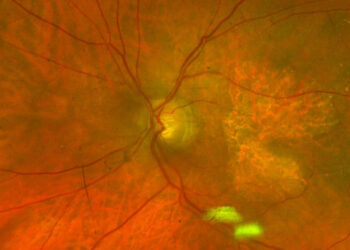TOPLINE:
Intermittent treatment with pimecrolimus 1% cream for 1 year was effective in reversing topical corticosteroid-induced skin damage in patients with atopic dermatitis. Pimecrolimus reduced skin damage by 30.5% on the face and by 38.6% on cubital areas, with skin thickness increases of 64.4% and 19.9%, respectively.
METHODOLOGY:
- Researchers conducted a 12-month, single-group phase 4 study involving 41 adult patients with mild-to-moderate atopic dermatitis and clinically evident skin atrophy due to long-term corticosteroid use on the face and cubital areas.
- Participants received intermittent treatment with pimecrolimus 1% cream at the first signs of disease until lesions cleared, with prednicarbate 0.25% cream as a rescue medication for major flares. The mean duration of treatment was 201 ± 106 days.
- The primary endpoint was the decrease in the Dermatophot score from baseline to the end of the study as a measure of the reconstitution of corticosteroid-damaged skin being treated with pimecrolimus cream.
TAKEAWAY:
- The Dermatophot score improved significantly from baseline — by 30.5% (95% CI, 20.8%-40.1%; P < .0001) on the face and 38.6% (95% CI, 28.2%-49.0%; P < .0001) on the cubital areas.
- Ultrasound measurements showed a 64.4% increase in facial skin thickness (P = .002) and a 19.9% increase in cubital area skin thickness (P < .02).
- At week 48, treatment success rates were 58.9% for facial lesions, 61.8% for cubital lesions, and 50.0% for whole-body lesions.
- Among subgroups defined by rescue medication use (> 33% vs ≤ 33% of the study period), those with lower exposure — using rescue medication for ≤ 33% of the study period — achieved numerically greater improvements in the Dermatophot score.
- Five patients experienced a total of six serious adverse events, none of which were considered related to the drug.
IN PRACTICE:
“In conclusion, this study demonstrated that long-term treatment with pimecrolimus 1% cream can lead to reconstitution of corticosteroid-damaged skin with favourable disease control,” the authors wrote.
SOURCE:
The study was led by Diamant Thaçi, MD, Institute and Comprehensive Center for Inflammation Medicine, University of Luebeck, Luebeck, Germany. It was published online on June 20, 2025, in the Journal of Dermatological Treatment.
LIMITATIONS:
The study did not include a control group receiving standard therapy. The researchers noted that without a randomized double-blind design, they could not definitively determine whether disease control with pimecrolimus treatment enabled self-healing of skin atrophy through steroid reduction or whether pimecrolimus itself actively improved skin atrophy through pharmacologic effects. Patients with severe atrophy (Dermatophot score > 6) were not included as reconstitution of damaged skin was expected to be difficult in such cases.
DISCLOSURES:
The study was funded by Novartis Pharma Germany. One author reported being a former employee of Novartis Pharma Germany. Some authors reported receiving honoraria or grants, serving on advisory boards, or having other ties with various sources.
This article was created using several editorial tools, including AI, as part of the process. Human editors reviewed this content before publication.
Source link : https://www.medscape.com/viewarticle/pimecrolimus-1-cream-shows-promise-reversing-corticosteroid-2025a1000ha7?src=rss
Author :
Publish date : 2025-07-03 12:00:00
Copyright for syndicated content belongs to the linked Source.









